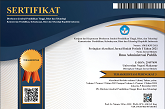E-Government Optimization Strategy at The Ministry of Villages, Development of Disadvantaged Regions, and Transmigration
(1) Faculty of Law, Social and Political Sciences, Indonesia Open University, Indonesia
(2) Faculty of Law, Social and Political Sciences, Indonesia Open University, Indonesia
(3) Administration of State Development, National Institute of Public Administration, Indonesia
(*) Corresponding Author
DOI: https://doi.org/10.26858/jiap.v13i1.46941
Abstract
This paper focuses on the e-Government optimization at The Ministry of Villages, Development of Disadvantaged Regions, and Transmigration as eGovernment has become one of the strategic issues of Bureaucratic Reform. This study aims to identify the aspects of an organization’s environment, to analyze, and formulate strategies for e-government optimization. Evaluation tools use the design-reality gap analysis through seven dimensions of ITPOSMO to assess the level of eGovernment implementation success and identified the critical success and failure factors. Strategy formulation techniques are using three stages of the strategy formulation analytical framework. Results from this study, by measuring the design-reality gap across seven dimensions show eGovernment project is likely to partially fail unless action is taken to correct the gap. Using three stages of the strategy formulation analytical framework defines four strategy recommendations: forward integration, related diversification, backward integration, and product development. Findings from this research will serve to reduce the risks that may affect e-governance success in The Ministry of Villages, Development of Disadvantaged Regions, and Transmigration.
Keywords
Full Text:
PDFReferences
Al-Hashmi, A., & Darem, A. (2008). Understanding phases of E-government project. Emerging Technologies in E-Government, 152–157. https://citeseerx.ist.psu.edu/viewdoc/download?doi=10.1.1.484.6913&rep=rep1&type=pdf
Aquinas, P. G. (2007). Principles of Management and Organisational Behaviour. In School of Distance Education Bharathiar University. Bharathiar University.
David, F. R. (2011). Strategic Management: Concept and Cases. In Pearson Education.
Dewia, L. K., & Kusumastuti, H. (2019). Integrasi Sistem Informasi pada Pemerintahan dengan e-Government. https://publikasi.fisip.unila.ac.id/index.php/sefila/article/view/22/10
Heeks, R. (2003). Most eGovernment-for-Development Projects Fail: How Can Risks be Reduced? In iGovernment Working Paper Series (IGovernment Working Paper Series). http://idpm.man.ac.uk/publications/wp/igov/index.shtml Educators’
Heeks, R. (2006). Implementing and Managing eGovernment: An International Text. In SAGE Publications. Sage Publisher.
Indonesia. (2018). Peraturan Presiden Republik Indonesia Nomor 95 Tahun 2018 tentang Sistem Pemerintahan Berbasis Elektronik.
Indonesia. (2019). Peraturan Menteri Desa, Pembangunan Daerah Tertinggal, dan Transmigrasi Republik Indonesia Nomor 22 Tahun 2019 tentang Penyelenggaraan Sistem Pemerintahan Berbasis Elektronik di Kementerian Desa, Pembangunan Daerah Tertinggal, dan Transmigrasi.
Indonesia. (2020). Peraturan Menteri Pendayagunaan Aparatur Negara dan Reformasi Birokrasi Republik Indonesia Nomor 25 Tahun 2020 tentang Road Map Reformasi Birokrasi 2020-2024.
Indrajit, R. E. (2016). Electronic Government (Vol. 84). https://www.academia.edu/30100450/Electronic_Government
Kementerian Pendayagunaan Aparatur Negara dan Reformasi Birokrasi. (2021). Laporan Hasil Evaluasi Sistem Pemerintahan Berbasis Elektronik Indeks SPBE Tahun 2021 Kementerian Desa, Pembangunan Daerah Tertinggal dan Transmigrasi.
La Adu, arifin, Hartanto, R., & Fauziati, S. (2022). Hambatan-Hambatan Dalam Implemetasi Layanan Sistem Pemerintahan Berbasis Elektronik (SPBE) Pada Pemerintah Daerah. JIKO (Jurnal Informatika Dan Komputer), 5(3), 215–223. https://doi.org/10.33387/jiko.v5i3.5344
Napitupulu, D., Sensuse, D. I., & Sucahyo, Y. G. (2017). Sosio-technical factors of e-government implementation. International Conference on Electrical Engineering, Computer Science and Informatics (EECSI), 4(September), 690–695. https://doi.org/10.11591/eecsi.4.1095
Ramanda, K., Fakriza, M. H., & Palasara, N. D. (2019). Evaluasi Keberhasilan Aplikasi Qlue Menggunakan Model ITPOSMO. Jurnal Sisfokom (Sistem Informasi Dan Komputer), 8(2), 98–104. https://doi.org/10.32736/sisfokom.v8i2.624
Rozikin, M., Hesty, W., & Sulikah, S. (2020). Kolaborasi dan E-Literacy: Kunci Keberhasilan Inovasi E-Government Pemerintah Daerah. Jurnal Borneo Administrator, 16(1), 61–80. https://doi.org/10.24258/jba.v16i1.603
Rudi, R., & Prasetia, A. M. (2018). Swot Analysis and Tows Matrix E-Government on Tana Tidung City of Kalimantan Utara. Elinvo (Electronics, Informatics, and Vocational Education), 3(1), 46–51. https://doi.org/10.21831/elinvo.v3i1.19518
Rusfiana, Y., & Supriatna, C. (2021). Memahami Birokrasi Pemerintahan dan Perkembangannya. Alfabeta.
Susilo, E. H. (2021). Tranformasi Sistem Pemerintahan Berbasis Elektronik Kementerian Energi dan Sumber Daya Mineral melalui Optimalisasi Teknologi Informasi Terintegrasi. Jurnal Pendidikan Tambusai, 5(3), 8101–8121. https://jptam.org/index.php/jptam/article/view/2306/2001
Wheelen, T. L., & Hunger, J. D. (2012). Scanning : Formulation : Implementation : External : Environment : (13th ed.). Prentice Hall.
Article Metrics
Abstract view : 323 times | PDF view : 63 timesRefbacks
- There are currently no refbacks.
Copyright (c) 2023 Hary Lasmana, Mani Festati Broto, Neneng Sri Rahayu

This work is licensed under a Creative Commons Attribution 4.0 International License.
Diterbitkan oleh:
Program Studi Ilmu Administrasi Publik
Program Pascasarjana Universitas Negeri Makassar
JIAP Index By:

This work is licensed under a Creative Commons Attribution 4.0 International License.









